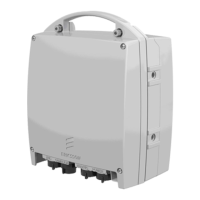MINI-LINK BAS 4-4
Technical Description EN/LZB 111 0542 P2B
4.2.1 Ethernet Frames Encapsulation According to
RFC 1483
The Ethernet frames received at the Ethernet 10/100 BaseT interface
of the NU are encapsulated in ATM cells according to RFC 1483.
The protocol stack for data traffic handling is shown in Figure 4-2. In
the figure it is assumed that the data flow is directed to an external
router where the IP protocol is processed. Note, however, that the
MINI-LINK BAS acts as a totally transparent system to the different
protocols running above the Ethernet layer protocol. Therefore data
transport is not limited to the IP protocol.
higher layers
Ethernet
PHY
End User
LAN
AT
LLC/SNAP
AAL-5
ATM
PHY
(RADIO)
PHY
Ethernet
ATM ATM
PHY
(RADIO)
PHY
(SDH)
Higher layers
LLC/SNAP
AAL-5
ATM
PHY
(SDH)
PHY
Ethernet
R-AASS
Permanent
Virtual
Comunication
MINI-LINK BAS
Ethernet 10base T
Router
(ISP)
Layer 2
or
Layer 3
ATM ATM
PHY
(SDH)
PHY
(SDH)
ATM
Node
Figure 4-2. Protocol Stack Model for Ethernet Frames in
MINI-LINK BAS
The connection through the MINI-LINK BAS is set via the EM as a
UBR PVC through the whole MINI-LINK BAS, shown as a dotted
line in Figure 4-2.
In that case local frames sent to local LAN MAC addresses are filtered
but not forwarded to the air interface. All broadcast/multicast
messages are passed over the bridge.
Note: FlexNU does not support the Spanning Tree Algorithm
(STA).
The Ethernet SU transceiver provides an auto-sensing 10/100 Base-T
interface, both half or full duplex, and complies with both IEEE 802.3
and Ethernet frame formats.
The encapsulation of the IEEE 802.3/Ethernet frames is in agreement
with RFC 1483 and RFC 2684. The encapsulation for the case of an
Ethernet frame is shown in Figure 4-3.
The Logical Link Control (LLC) or the VC multiplexing option and
the Frame Checking Sequence (FCS) presence are selectable by EM
on per connection basis.

